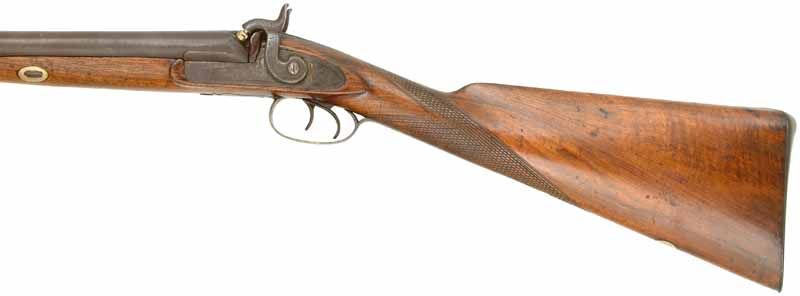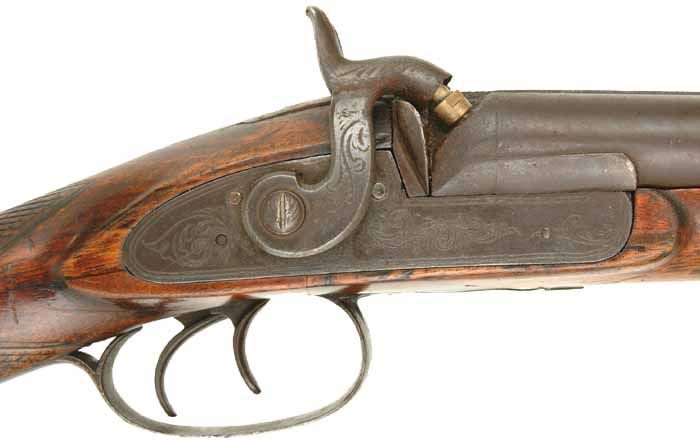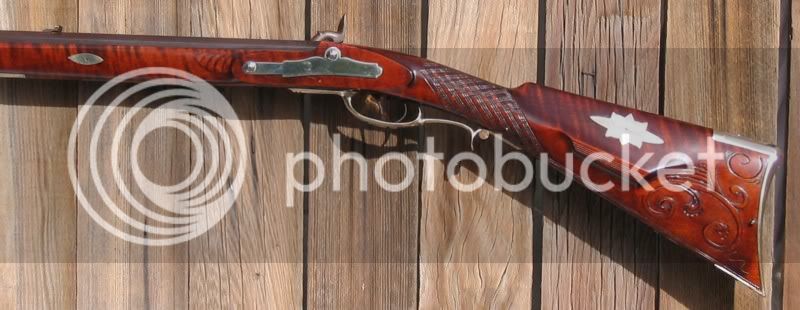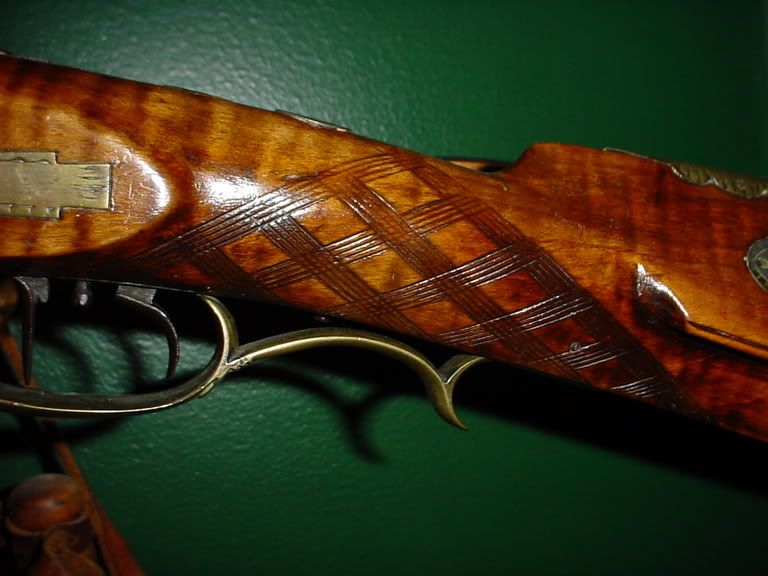My SXS muzzleloading shotgun needs checkering and with a little coaching from Herb and others here, I will buy what I need and do it myself. Years ago I checkered a CVA Mt Rifle kit and at that time used I think 16 lines per inch because it seemed to me that old guns are checkered quite differently than the ones today - the diamonds were more square and not as sharp on top... would you agree?
You are using an out of date browser. It may not display this or other websites correctly.
You should upgrade or use an alternative browser.
You should upgrade or use an alternative browser.
Modern vs. original checkering
- Thread starter Liver eatin’ Johnson
- Start date

Help Support Muzzleloading Forum:
This site may earn a commission from merchant affiliate
links, including eBay, Amazon, and others.
Guest
Livereatin', I would agree with your observation. I own and have examined many, many vintage firearms and it is obvious that pre-1900 checkering is much flatter on the tops, both continental and domestic, and not nearly so much of a decoration as it is today. Several of those old rifles I've examined were "as new" and the checkering was flat topped so it wasn't from use that it was smoother. Higher grade guns of yesteryear had more refined checkering, as is the case today.
I can't really say why because to my hand the sharp, well pointed up checkering of today is much more sure in hand than the older flat topped style. Perhaps it was a wear issue or the time required to accomplish the task. Hopefully someone will have a more devinitive answer.
Vic
I can't really say why because to my hand the sharp, well pointed up checkering of today is much more sure in hand than the older flat topped style. Perhaps it was a wear issue or the time required to accomplish the task. Hopefully someone will have a more devinitive answer.
Vic
Tools are available to do flattop checkering (also called English checkering)as it was used on most if not all english guns of the 1800s. It didn't show wear as quickly
and the diamonds didn't break off as easily especially when doing 32lines per inch or more.
and the diamonds didn't break off as easily especially when doing 32lines per inch or more.
robinghewitt
62 Cal.
- Joined
- Jun 26, 2004
- Messages
- 2,605
- Reaction score
- 23
it was used on most if not all english guns of the 1800s.
I thought, "surely not" :hmm: Went to look, and you are 100% right ::
Good point Deadeye - now where to find such a tool... :hmm:
From TOTW:
"This antique double shotgun has Birmingham proof marks under the breeches."

From TOTW:
"This antique double shotgun has Birmingham proof marks under the breeches."

robinghewitt
62 Cal.
- Joined
- Jun 26, 2004
- Messages
- 2,605
- Reaction score
- 23
"This antique double shotgun has Birmingham proof marks under the breeches."
...and no maker's name. I think I have the same gun ::
A 16 gauge, am I right? :thumbsup:
Not quite :winking: 13 gauge, percussion double shotgun.
"This antique double shotgun has Birmingham proof marks under the breeches. The locks and barrels are unmarked as to the maker.
Stocked in European walnut, the buttstock has numerous small handling marks from over a century of use. The checkering at the wrist has become slightly worn, from normal use. We did note a repair to the lower lock panels where a new piece of wood has been fitted to repair a chip. The stock varnish has become worn, but the stock does not appear to have been sanded."

"This antique double shotgun has Birmingham proof marks under the breeches. The locks and barrels are unmarked as to the maker.
Stocked in European walnut, the buttstock has numerous small handling marks from over a century of use. The checkering at the wrist has become slightly worn, from normal use. We did note a repair to the lower lock panels where a new piece of wood has been fitted to repair a chip. The stock varnish has become worn, but the stock does not appear to have been sanded."

robinghewitt
62 Cal.
- Joined
- Jun 26, 2004
- Messages
- 2,605
- Reaction score
- 23
It is very similar. Looking close up I think I may have the posh version ::
LEJ, I haven't looked for them lately but I believe Brownell's has them. They used to carry them.
If you interested in checkering get the book, Checkering and Carving gunstocks by Monte Kennedy, It's THE book on checkering. I've had my copy for about 40 yrs and I used it to get started checkering. It will tell you all about flat top checkering.
If you interested in checkering get the book, Checkering and Carving gunstocks by Monte Kennedy, It's THE book on checkering. I've had my copy for about 40 yrs and I used it to get started checkering. It will tell you all about flat top checkering.
Flat top checkering tool? I suppose such a tool is out there somewhere, but I wonder, why?
If you don't cut the checkering deep, it will have flat tops naturally.
If you cut it too deep, a little 600 grit sandpaper will fix that in no time at all!
If you don't cut the checkering deep, it will have flat tops naturally.
If you cut it too deep, a little 600 grit sandpaper will fix that in no time at all!
Ok Zonie,
That's way too logical... So I can just buy any 16 -18 lpi set and just not deepen the grooves? :: Would the spacing stay consistant that way?
That's way too logical... So I can just buy any 16 -18 lpi set and just not deepen the grooves? :: Would the spacing stay consistant that way?
I am a complete novice when it comes to doing really fine checkering.
My method is to mark the main layout line in each direction (like at 60-90 degrees to each other) and then carefully cut it in just deep enough so the spacing file can follow it withoug jumping out of the groove.
I then use the spacing file (one smooth tooth in the guide groove and one tooth with file teeth on it) to space the lines. Again, I only go deep enough to make a groove for the guide tooth to follow.
I then go back and deepen each groove to about 3/4 depth in both directions. I use the double file to do this unless I am approaching the end of the panal and use the single file to finish the grooves to a uniform stopping line.
If I havent frinkeled it up, I then go back and complete the grooves to the depth I desire.*
Because the 18th and 19th century checkering was often flat topped, the depth I consider finished is not the full point forming type we use today.
If you are going to try this remember to GO SLOW. If the file jumps out of the groove it can really frinkel up the wood between the lines.
* If I did frinkel it up, I have been known to say "Why would anyone want checkering there in the first place?" and just sand off the disaster. (Happened on my Pedersoli Tryon). :boohoo:
My method is to mark the main layout line in each direction (like at 60-90 degrees to each other) and then carefully cut it in just deep enough so the spacing file can follow it withoug jumping out of the groove.
I then use the spacing file (one smooth tooth in the guide groove and one tooth with file teeth on it) to space the lines. Again, I only go deep enough to make a groove for the guide tooth to follow.
I then go back and deepen each groove to about 3/4 depth in both directions. I use the double file to do this unless I am approaching the end of the panal and use the single file to finish the grooves to a uniform stopping line.
If I havent frinkeled it up, I then go back and complete the grooves to the depth I desire.*
Because the 18th and 19th century checkering was often flat topped, the depth I consider finished is not the full point forming type we use today.
If you are going to try this remember to GO SLOW. If the file jumps out of the groove it can really frinkel up the wood between the lines.
* If I did frinkel it up, I have been known to say "Why would anyone want checkering there in the first place?" and just sand off the disaster. (Happened on my Pedersoli Tryon). :boohoo:
English flat top checkering isn't cut to a V at the bottom
but is more of a U shape cut so no matter how deep it's cut the top will still be flat, when you leave flat tops on
V cut checkering it always looks like the cut hasn't been
finished, which it hasn't.
but is more of a U shape cut so no matter how deep it's cut the top will still be flat, when you leave flat tops on
V cut checkering it always looks like the cut hasn't been
finished, which it hasn't.
Deadeye: I think your comment "... when you leave flat tops on
V cut checkering it always looks like the cut hasn't been
finished, which it hasn't. " is true when applied to modern arms and some British arms. I'm sure it is also true to you when you look at a gun.
From what I have read and seen, it is not necessarly true for longrifles made 150 years ago.
Some of the rifles made by Melchior Fordney (Lancaster Pa) in the 1830-1846 period look to have checkering which is not fully pointed, and definatly is of the V shape. (Ref Gunsmiths of Lancaster County by Dr James B Whisker pp97-102 and The Kentucky Rifle by The Kentucky Rifle Association 1967 pp 32-33.)
:imo: In these photos, the highlights in the checkering could have only been caused by V shaped grooves.
IMO there were several gunsmiths back then, who seemed to use checkering as a form of decoration rather than the functional grip enhancing feature we think of today.
V cut checkering it always looks like the cut hasn't been
finished, which it hasn't. " is true when applied to modern arms and some British arms. I'm sure it is also true to you when you look at a gun.
From what I have read and seen, it is not necessarly true for longrifles made 150 years ago.
Some of the rifles made by Melchior Fordney (Lancaster Pa) in the 1830-1846 period look to have checkering which is not fully pointed, and definatly is of the V shape. (Ref Gunsmiths of Lancaster County by Dr James B Whisker pp97-102 and The Kentucky Rifle by The Kentucky Rifle Association 1967 pp 32-33.)
:imo: In these photos, the highlights in the checkering could have only been caused by V shaped grooves.
IMO there were several gunsmiths back then, who seemed to use checkering as a form of decoration rather than the functional grip enhancing feature we think of today.
Zonie, I think your right about the decoration and I have duplicated flat top checkering using V tools but never thought it looked just right to my eye. I looked in Brownell's catalog , yesterday, and didn't find any tools for doing flat top though I believe they used to have them.
I also looked at an old single shot Wesley Richards rifle
that I have to see some flat top and wouldn't you know ,it had V checkering. It' from 1870s or 80s.
Could the Fordney checkering have been worn flat, doesn't take much to flatten them.
I also looked at an old single shot Wesley Richards rifle
that I have to see some flat top and wouldn't you know ,it had V checkering. It' from 1870s or 80s.
Could the Fordney checkering have been worn flat, doesn't take much to flatten them.
It's possible that the checkering was worn some. After all, he was killed by his neighbor in 1846, so his guns have been around a few years. (His neighbor pleaded insanity but the court hung him anyway.) ::
Even if some of it was originally pointed, his style of multiple skip line checkering is hardly what one would call pointed (at least in the open areas).
M. Fordneys skip line checkering is what I tried to follow when I made this:

Even if some of it was originally pointed, his style of multiple skip line checkering is hardly what one would call pointed (at least in the open areas).
M. Fordneys skip line checkering is what I tried to follow when I made this:

Dan'l: Update any posts you want to, and thanks for the photo.
IMO, the skip block checkering pattern shown in your picture makes for a really nice addition to a stock.
From the reading I have done, I haven't seen this style on the older pre 1800 guns, but several gunsmiths in the 1800-1850s used it.
Thanks again.
IMO, the skip block checkering pattern shown in your picture makes for a really nice addition to a stock.
From the reading I have done, I haven't seen this style on the older pre 1800 guns, but several gunsmiths in the 1800-1850s used it.
Thanks again.
- Joined
- Apr 3, 2004
- Messages
- 15,602
- Reaction score
- 22
Argh...I want checkering on my new project just like Zonies rifle. Guess I need to look up tools and how to books and start practicing. :hmm:
Similar threads
- Replies
- 22
- Views
- 2K
- Locked
- Replies
- 20
- Views
- 3K





